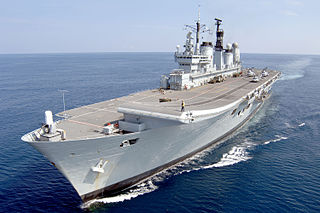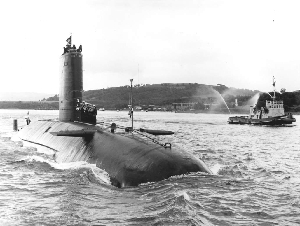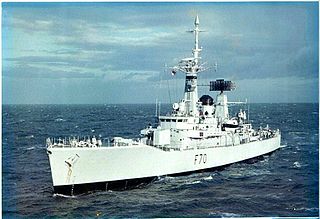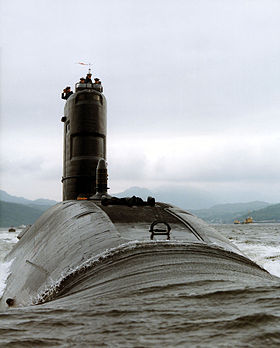
The Trafalgar class is a class of nuclear-powered fleet submarines (SSNs) in service with the Royal Navy, and the successor to the Swiftsure class. Like the majority of Royal Navy nuclear submarines, all seven boats were constructed at Barrow-in-Furness shipyard, Cumbria. With only one boat remaining active and in commission and six retired from the seven originally in service, the class makes up part of the Royal Navy's nuclear-powered ‘hunter-killer’ submarine force. The Trafalgar class has nearly been replaced by the larger and more capable Astute class, of which five are commissioned.

The Astute class is the latest class of nuclear-powered fleet submarines (SSNs) in service with the Royal Navy. The boats are being constructed by BAE Systems Submarines at Barrow-in-Furness. Seven boats will be constructed: the first of class, Astute, was launched by Camilla, Duchess of Cornwall, in 2007, commissioned in 2010, and declared fully operational in May 2014. The Astute class is the replacement for the Trafalgar-class fleet submarines in Royal Navy service.

The Invincible class was a class of light aircraft carrier operated by the Royal Navy. Three ships were constructed: HMS Invincible, HMS Illustrious and HMS Ark Royal. The vessels were built as aviation-capable anti-submarine warfare (ASW) platforms to counter the Cold War North Atlantic Soviet submarine threat, and initially embarked Sea Harrier aircraft and Sea King HAS.1 anti-submarine helicopters. With cancellation of the aircraft carriers renewal programme in the 1960s, the three ships became the replacements for Ark Royal and Eagle fleet carriers and the Centaur-class light fleet carriers, and the Royal Navy's sole class of aircraft carrier.

HMS Splendid was a Royal Navy nuclear-powered fleet submarine of the Swiftsure class. From commissioning in 1979 to her decommission in 2004 she took part in many operations involving British forces around the globe.

HMS Conqueror was a British Churchill-class nuclear-powered fleet submarine which served in the Royal Navy from 1971 to 1990. She was the third submarine of her class, following the earlier Churchill and Courageous, that were all designed to face the Soviet threat at sea. She was built by Cammell Laird at Birkenhead.

The Type 42 or Sheffield class, was a class of fourteen guided-missile destroyers that served in the Royal Navy. A further two ships of this class were built for and served with the Argentine Navy.

HMS Triumph is a Trafalgar-class nuclear submarine of the Royal Navy and was the seventh and final boat of her class. She is the nineteenth nuclear-powered hunter-killer submarine built for the Royal Navy. Triumph is the tenth vessel, and the second submarine to bear the name. The first HMS Triumph was a 68-gun galleon built in 1561. As of 2022, she is the last boat of her class remaining in service.

The Type 22 frigate also known as the Broadsword class was a class of frigates built for the British Royal Navy. Fourteen were built in total, with production divided into three batches.

HMS Spartan was a nuclear-powered fleet submarine of the Royal Navy's Swiftsure class. Spartan was launched on 7 April 1978 by Lady Lygo, wife of Admiral Sir Raymond Lygo. The boat was built by Vickers Limited Shipbuilding Group at Barrow-in-Furness in Cumbria, England. She was decommissioned in January 2006.

HMS Superb was a nuclear-powered fleet submarine of the Swiftsure class serving in the Royal Navy.

The Leander-class, or Type 12I (Improved) frigates, comprising twenty-six vessels, was among the most numerous and long-lived classes of frigate in the Royal Navy's modern history. The class was built in three batches between 1959 and 1973. It had an unusually high public profile, due to the popular BBC television drama series Warship. The Leander silhouette became synonymous with the Royal Navy through the 1960s until the 1980s.
The Rolls-Royce pressurised water reactor (PWR) series has powered the Royal Navy's nuclear submarines since the Valiant class, commissioned in 1966.
The fifth HMS Sceptre is a Swiftsure-class submarine built by Vickers in Barrow-in-Furness. She was launched in 1976, with a bottle of cider against her hull. She was commissioned on 14 February 1978, by Lady Audrey White. She was the tenth nuclear fleet submarine to enter service with the Royal Navy. She was decommissioned on 10 December 2010, at which time she was the oldest commissioned vessel in the Royal Navy still available for service; in total around 1,500 men served aboard during her commission. In theory, she is replaced by the first Astute-class submarine in service, HMS Astute.

The Commander-in-Chief Fleet (CINCFLEET) was the admiral responsible for the operations of the ships, submarines and aircraft of the British Royal Navy from 1971 until April 2012. The post was subordinate to the First Sea Lord, the professional head of the Naval Service. In its last years, as the Navy shrank, more administrative responsibilities were added.
HMS Swiftsure was the lead ship of her class of nuclear fleet submarines built for the Royal Navy. Entering service in 1973, she served until 1992.

The Royal Navy Submarine Service is one of the five fighting arms of the Royal Navy. It is sometimes known as the Silent Service, as submarines are generally required to operate undetected.

HMS Anson is the fifth Astute-class nuclear-powered fleet submarine of the Royal Navy. She is the eighth vessel of the Royal Navy to bear the name, after Admiral George Anson.
HMS Agamemnon is the sixth Astute-class nuclear-powered fleet submarine of the Royal Navy and is currently under construction. She will be the sixth vessel of the Royal Navy to bear the name, after the legendary Greek king Agamemnon.
In 1989 the Royal Navy was under the direction of the Navy Department in the UK Ministry of Defence. It had two main commands, CINCFLEET and Naval Home Command.














